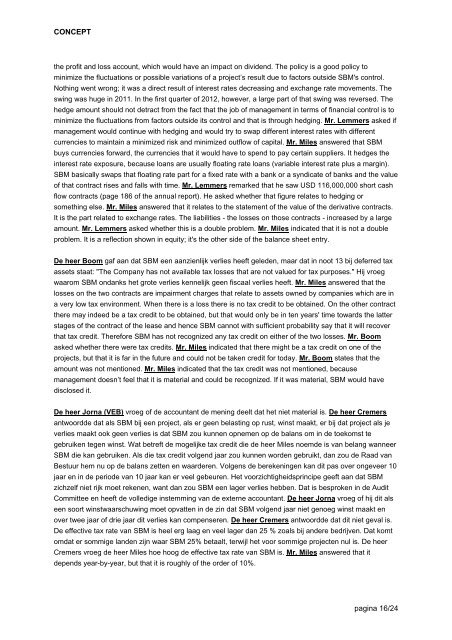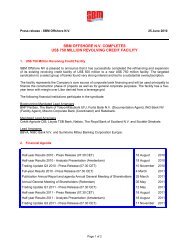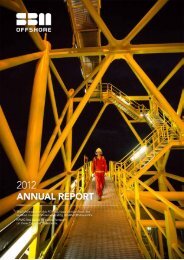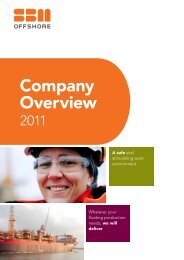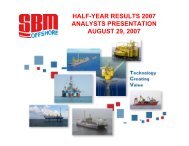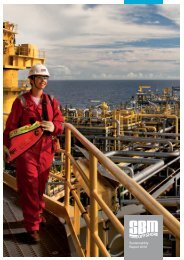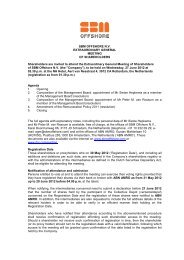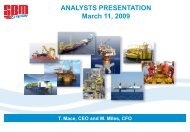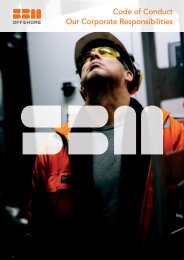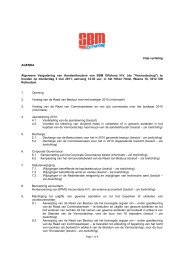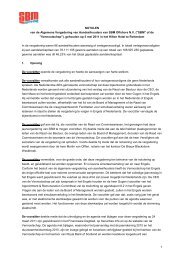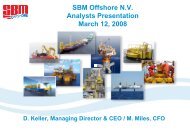CONCEPT pagina 1/24 - SBM Offshore
CONCEPT pagina 1/24 - SBM Offshore
CONCEPT pagina 1/24 - SBM Offshore
You also want an ePaper? Increase the reach of your titles
YUMPU automatically turns print PDFs into web optimized ePapers that Google loves.
<strong>CONCEPT</strong><br />
the profit and loss account, which would have an impact on dividend. The policy is a good policy to<br />
minimize the fluctuations or possible variations of a project’s result due to factors outside <strong>SBM</strong>'s control.<br />
Nothing went wrong; it was a direct result of interest rates decreasing and exchange rate movements. The<br />
swing was huge in 2011. In the first quarter of 2012, however, a large part of that swing was reversed. The<br />
hedge amount should not detract from the fact that the job of management in terms of financial control is to<br />
minimize the fluctuations from factors outside its control and that is through hedging. Mr. Lemmers asked if<br />
management would continue with hedging and would try to swap different interest rates with different<br />
currencies to maintain a minimized risk and minimized outflow of capital. Mr. Miles answered that <strong>SBM</strong><br />
buys currencies forward, the currencies that it would have to spend to pay certain suppliers. It hedges the<br />
interest rate exposure, because loans are usually floating rate loans (variable interest rate plus a margin).<br />
<strong>SBM</strong> basically swaps that floating rate part for a fixed rate with a bank or a syndicate of banks and the value<br />
of that contract rises and falls with time. Mr. Lemmers remarked that he saw USD 116,000,000 short cash<br />
flow contracts (page 186 of the annual report). He asked whether that figure relates to hedging or<br />
something else. Mr. Miles answered that it relates to the statement of the value of the derivative contracts.<br />
It is the part related to exchange rates. The liabilities - the losses on those contracts - increased by a large<br />
amount. Mr. Lemmers asked whether this is a double problem. Mr. Miles indicated that it is not a double<br />
problem. It is a reflection shown in equity; it's the other side of the balance sheet entry.<br />
De heer Boom gaf aan dat <strong>SBM</strong> een aanzienlijk verlies heeft geleden, maar dat in noot 13 bij deferred tax<br />
assets staat: "The Company has not available tax losses that are not valued for tax purposes." Hij vroeg<br />
waarom <strong>SBM</strong> ondanks het grote verlies kennelijk geen fiscaal verlies heeft. Mr. Miles answered that the<br />
losses on the two contracts are impairment charges that relate to assets owned by companies which are in<br />
a very low tax environment. When there is a loss there is no tax credit to be obtained. On the other contract<br />
there may indeed be a tax credit to be obtained, but that would only be in ten years' time towards the latter<br />
stages of the contract of the lease and hence <strong>SBM</strong> cannot with sufficient probability say that it will recover<br />
that tax credit. Therefore <strong>SBM</strong> has not recognized any tax credit on either of the two losses. Mr. Boom<br />
asked whether there were tax credits. Mr. Miles indicated that there might be a tax credit on one of the<br />
projects, but that it is far in the future and could not be taken credit for today. Mr. Boom states that the<br />
amount was not mentioned. Mr. Miles indicated that the tax credit was not mentioned, because<br />
management doesn’t feel that it is material and could be recognized. If it was material, <strong>SBM</strong> would have<br />
disclosed it.<br />
De heer Jorna (VEB) vroeg of de accountant de mening deelt dat het niet material is. De heer Cremers<br />
antwoordde dat als <strong>SBM</strong> bij een project, als er geen belasting op rust, winst maakt, er bij dat project als je<br />
verlies maakt ook geen verlies is dat <strong>SBM</strong> zou kunnen opnemen op de balans om in de toekomst te<br />
gebruiken tegen winst. Wat betreft de mogelijke tax credit die de heer Miles noemde is van belang wanneer<br />
<strong>SBM</strong> die kan gebruiken. Als die tax credit volgend jaar zou kunnen worden gebruikt, dan zou de Raad van<br />
Bestuur hem nu op de balans zetten en waarderen. Volgens de berekeningen kan dit pas over ongeveer 10<br />
jaar en in de periode van 10 jaar kan er veel gebeuren. Het voorzichtigheidsprincipe geeft aan dat <strong>SBM</strong><br />
zichzelf niet rijk moet rekenen, want dan zou <strong>SBM</strong> een lager verlies hebben. Dat is besproken in de Audit<br />
Committee en heeft de volledige instemming van de externe accountant. De heer Jorna vroeg of hij dit als<br />
een soort winstwaarschuwing moet opvatten in de zin dat <strong>SBM</strong> volgend jaar niet genoeg winst maakt en<br />
over twee jaar of drie jaar dit verlies kan compenseren. De heer Cremers antwoordde dat dit niet geval is.<br />
De effective tax rate van <strong>SBM</strong> is heel erg laag en veel lager dan 25 % zoals bij andere bedrijven. Dat komt<br />
omdat er sommige landen zijn waar <strong>SBM</strong> 25% betaalt, terwijl het voor sommige projecten nul is. De heer<br />
Cremers vroeg de heer Miles hoe hoog de effective tax rate van <strong>SBM</strong> is. Mr. Miles answered that it<br />
depends year-by-year, but that it is roughly of the order of 10%.<br />
<strong>pagina</strong> 16/<strong>24</strong>


